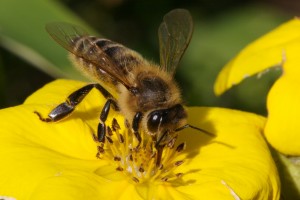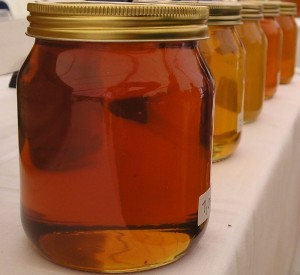Honey, particularly manuka honey and raw honey is often praised for its health benefits. This had lead to many people using honey as a sugar alternative on foods, in drinks and as a natural treatment for wounds. This article will explain the differences between manuka, raw and regular honey, investigate their health benefits.
Honey, sugar & medicine
Historically, sugar was not easily obtained, and the only available source of sugar was honey. Other than its sweet taste, one of the main uses of honey was to treat wounds because it possesses antibacterial properties, which prevented infection and allowed the wound to heal. Honey’s antibacterial properties come from its high sugar content, which changes the osmotic pressure in the applied area, which draws out water. This dehydrating effect prevents bacteria from growing and kills any present bacteria as they require water to grow1.
Today, honey is known to contain a number of plant and bee derived chemicals which posses additional antibacterial properties. These compounds do contribute to the antibacterial properties of honey, but this is very variable, and depends on a number of factors such as processing and the plants used to source the honey. Refined sugar by itself posses powerful antibacterial properties, and as it is cheap and easily available today, it is often a very suitable substitute to honey.
Generic honey
Generic, or ‘table’ honey is poorly regulated and very inconsistent in quality, origin, age and even contents. This was highlighted by the testing of honey in 2011, which showed that many jars of honey actually contained very little honey, and were higher in corn syrup, antibiotics and artificial sweeteners (some of which are illegal)2. The combination of heat treatment, filtration, blending and additional ingredients makes most generic honey little more than sugar syrup, and can only be considered as such. The processing will remove and/ or destroy most of the bio-active components of honey, meaning the only beneficial properties generic honey can have are the same as sugar.
Health benefits of manuka honey
Manuka honey is simply honey made from one specific plant – the manuka tree, which is found in New Zealand. This means that manuka honey will not contain blends of various types of honey, and so any bio-active compounds found in it will be consistent. It is widely marketed as having powerful medical and health properties, and as being a much superior product to generic honey. Indeed, manuka honey is much better regulated, and if it is called manuka honey on the jar, you can be much more confident that it will actually be manuka honey in the jar, rather than sugar syrup and sweeteners.
Manuka honey is known to have a much higher concentration of a natural antibacterial compound called methylglyoxal (MGO) compared to regular honey3, and this is sometimes seen on the label of manuka honey. Methylglyoxal is very heat stable, and so although heat processing may damage other bio-active compounds in manuka honey, methylglyoxal will remain intact and will be present in the final product. The MGO in manuka honey has been shown to inhibit a number of known pathogenic bacteria such as Escherichia coli (E. coli) and Staphylococcus aureus (S. aureus) in some studies. However, there are some studies which have concluded that although methylglyoxal does have antibacterial properties, its effects are negligible to that of the antibacterial properties of sugar when it is used to treat wounds3. Consumption of manuka honey may offer antibacterial benefits for the health of the digestive system which sugar alone cannot, but research is limited for this.
A number of other bio-active compounds have been identified in manuka honey and these are thought to exert beneficial properties on the body when consumed. There is very little investigation into these individual compounds, however, collectively, these do exert significant antibacterial properties, which adds to the antibacterial properties of manuka honey. These compounds are not all as stable as methylglyoxal, and degrade in the presence of heat/ light, which will reduce the total antibacterial properties of manuka honey. This is of particular concern, as most honey will be heat treated before it is sold, and will also be stored in clear glass jars – causing much of these compounds to become useless. In order to express the total antibacterial properties of manuka honey at sale, all manuka honey is given a score called a Unique Manuka Factor (UMF) score to indicate its antibacterial potency. This score is trademarked and considered to be a reliable medical measure of the antibacterial properties of manuka honey, and it is largely dictated by the quantity of methylglyoxal present in the honey.
Health benefits of raw honey
Raw honey can be sourced from any plant, but is unique in that it hasn’t undergone any heat processing before it is sold, resulting in a ‘raw’ or uncooked product with the vast majority of bio-active compounds intact. Raw honey will contain a much greater variety of bio-active compounds, and often in a much greater quantity than generic honey or manuka honey, but as raw honey can be made form any plant, the quantity and variety of plant derived compounds is very variable. However, bee derived compounds will be much more consistent in their presence and quantity. One such compound is a peptide called bee-defensin, which exists in 2 forms (bee defensin-1 and bee defensin-2), and is a natural part of the bee-hives immune system. This peptide is a known antibacterial agent, and consumption of it is thought to help promote digestive system health and the immune system, although conclusive evidence is limited.
Other compounds found in raw honey include a number of polyphenols, such as caffeic acid and catechins4 (which are also found in green tea). These polyphenols are known to exert antioxidant properties on the body5, which can help the body protect against a range of ailments which are associated with oxidative damage. Although a number of these compounds will also be in manuka honey, and possibly generic honey, they will generally be found in higher quantities in raw honey.
Is honey healthy to eat?
With the antibacterial and antioxidant components of honey, it is easy to think that it is healthy to eat. However, honey contains large amounts of sugar, and so should not be consumed regularly, especially if you follow a typical western diet, which is high in refined carbohydrates. Raw/ manuka honey makes a healthier alternative to refined sugar, but it is only advisable to consume infrequently to avoid increasing the risk of type 2 diabetes/ damaging the cardiovascular system.
Summary
Manuka honey and raw honey both contain additional antibacterial compounds, which may offer additional health benefits to the digestive system, but are unlikely of offer additional benefits to treating wounds, as sugar alone is a very effective antibacterial treatment. Manuka honey is much more consistent in its content, and is tested for its antibacterial potency, however, due to its heat treatment, it is unlikely to be very high in additional bio-active compounds such as bee-defensin and various polyphenols. Raw honey on the other hand, is more likely to be higher in these compounds, but as raw honey is not tested for quantity of these, and is very variable in the plants it is created from, a high content cannot be guaranteed.
It is important to remember the high sugar content of all honey, and although it may contain beneficial compounds which can promote our health, the high sugar content will still have an impact on insulin levels.
References
1. Melissa A. Mundo, Olga I. Padilla-Zakour. (2004). Growth inhibition of foodborne pathogens and food spoilage organisms by select raw honeys. International Journal of Food Microbiology. 97 (1), 1-8.
2.Andrew Schneider |. (2011). Tests Show Most Store Honey Isn’t Honey . Available: http://www.foodsafetynews.com/2011/11/tests-show-most-store-honey-isnt-honey/#.UvybjbR7Rek. Last accessed 13/02/2014.
3. Elvira Mavric. (2008). Identification and quantification of methylglyoxal as the dominant antibacterial constituent of Manuka (Leptospermum scoparium) honeys from New Zealand. Molecular nutrition. 52 (4), 483-489.
4. Paulus H. S. Kwakma. (2012). Antibacterial components of honey. Life. 64 (1), 48-55.
5. Roderick J Weston. (1999). Antibacterial phenolic components of New Zealand manuka honey. Food Chemistry. 64 (3), 295-301.
6. Manuela Blasa. (2006). Raw honey is packed full of antioxidants. Food Chemistry. 97 (2), 217–222.
%CODE_MANUKA%
Images courtesy of alsjhc, Mamboman1 and brockvicky.



